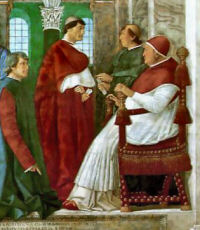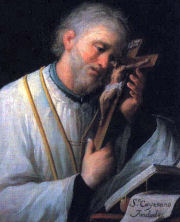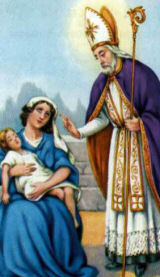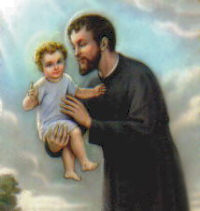Ordinary Time: August 7th
Friday of the Eighteenth Week of Ordinary Time; Optional Memorial of Sts. Sixtus II, pope and martyr and companions, martyrs and Optional Memorial of St. Cajetan, priest
Other Commemorations: St. Donatus of Arezzo, Martyr (RM) ; Other Titles: Donato
» Enjoy our Liturgical Seasons series of e-books!
With the future Pope Paul IV, St. Cajetan founded the first congregation of Clerks Regular, a new form of institute which corresponded with the needs of the time. Trust in God was its principal rule; its members were forbidden to ask for alms and depended entirely on the spontaneous charity of the faithful. Such was Cajetan's zeal in seeking the salvation of souls that he came to be called "the hunter of souls." He died at Naples on August 7, 1547.
Today is also the feast of Sts. Sixtus II and his companions, Felicissimus and Agapitus. Pope Sixtus II was one of the first victims of the persecution under the Emperor Valerian. Felicissimus and Agapitus were two of his deacons who were executed with him. Sixtus governed the Church from 256 to 258. His name is mentioned in the Canon of the Mass.
St. Sixture and St. Cajetan's feasts are celebrated today both in the Ordinary Form and the Extraordinary Form of the Roman Rite.
According to the 1962 Missal of St. John XXIII the Extraordinary Form of the Roman Rite, today is the feast of St. Donatus. His name occurs second on the list of the bishops of the See of Arezzo. Little is known of him. The Acts of his martyrdom, unfortunately, do not merit credence.
St. Sixtus II and companions
 Even as the storm of persecution created by Emperor Valerian raged against the Church, the papal throne was not vacant. Sixtus, a Greek, was elected to succeed Stephen. The emperor's decrees had ordered the Christians to take part in state religious ceremonies and forbade them to assemble in cemeteries. For nearly a year Sixtus managed to evade the authorities before he was gloriously martyred.
Even as the storm of persecution created by Emperor Valerian raged against the Church, the papal throne was not vacant. Sixtus, a Greek, was elected to succeed Stephen. The emperor's decrees had ordered the Christians to take part in state religious ceremonies and forbade them to assemble in cemeteries. For nearly a year Sixtus managed to evade the authorities before he was gloriously martyred.
Valerian issued his second edict ordering the execution of Christian bishops, priests, and deacons. Sixtus had taken to holding services in the private cemetery of Praetextatus because it was not watched as closely by the authorities as was the cemetery of Calixtus. But in early August of 258, while Sixtus was seated on his episcopal chair and surrounded by the brethren, the soldiers broke in arresting Sixtus and four deacons who were in attendance. After a formal judgment, Sixtus was led back to the very place where he had been arrested, to face execution. His chief deacon Lawrence, upon hearing the news, hastened to his side, desiring to die with his bishop. Sixtus consoled his deacon by telling him that he would follow in three days with even greater glory. The soldiers then placed Sixtus in his chair and swiftly beheaded him. True to the great pope's words, Lawrence was arrested three days later and executed the same day.
—Excerpted from The Popes: A Papal History, J.V. Bartlett
Symbols and Representation: Cross; sword.
Often Portrayed As: Giving Saint Lawrence a bag of money to give to the poor; with Saint Lawrence; with Saint Lawrence and Saint John the Baptist.
Patronage: Bellegra, Italy
Highlights and Things to Do:
- Learn more about Sts. Sixtus II & Felicissimus & Agapitus:
- The relics of St. Sixtus are located in Basilica of San Sisto Vecchio.
St. Cajetan
 Cajetan, a co-founder of the Theatines, received the office of protonotary at Rome from Pope Julius II when still quite young. After he was ordained priest in 1516, he left the papal court and dedicated himself entirely to the service of the Lord. With his own hands he cared for the sick. Such zeal did he show for the salvation of his fellowmen that he was surnamed the "huntsman for souls."
Cajetan, a co-founder of the Theatines, received the office of protonotary at Rome from Pope Julius II when still quite young. After he was ordained priest in 1516, he left the papal court and dedicated himself entirely to the service of the Lord. With his own hands he cared for the sick. Such zeal did he show for the salvation of his fellowmen that he was surnamed the "huntsman for souls."
In order to raise the standards of ecclesiastical discipline among the clergy, Cajetan founded in 1524 a community of Clerks Regular who were to lead an apostolic life. They were to look with disdain upon all earthly belongings, to receive no income, to accept no salaries from the faithful; only from that which was freely offered were they allowed to retain the means of livelihood. Thus they were to rely unreservedly upon Divine Providence.
St. Cajetan often prayed eight hours daily. He was particularly active during the Breviary reform under Pope Clement VII. He was kind, mild, but above all, humble. He asked God that no one should know the place of his burial. While attending the Christmas celebration at St. Mary of the Crib, he is said to have been given the grace of receiving from Mary the Child Jesus into his arms. During the sack of Rome by the soldiers of Charles V in 1527, he was tortured and cast into prison because he refused to surrender certain church monies which, in fact, he had distributed among the poor. An insurrection filled him with such grief and sorrow that he took sick and died.
—Excerpted from The Church's Year of Grace, Pius Parsch
Patronage: job seekers; unemployed; Theatines; Santo Stefano Medio, Messina, Italy
Highlights and Things to Do:
- Read more bout St. Cajetan:
- See the statues of St. Cajetan at St. Peter's Basilica: on the Colonnade and the Founder's Statue.
- St. Cajetan's relics are located in Naples in the Basilica San Paolo Maggiore. See New Liturgical Movement has more about the Basilica.
- Visit Catholic Cuisine for some feast day food ideas.
- Watch this YouTube video about St. Cajetan.
- Find some prayers to St. Cajetan here.
St. Donatus
 St. Donatus, Bishop and Martyr who suffered martyrdom under Emperor Julian the Apostate, in 361. This Bishop of Arezzo in Tuscany was illustrious for his sanctity and for his gift of working miracles. The Church has always remembered him with the highest veneration.
St. Donatus, Bishop and Martyr who suffered martyrdom under Emperor Julian the Apostate, in 361. This Bishop of Arezzo in Tuscany was illustrious for his sanctity and for his gift of working miracles. The Church has always remembered him with the highest veneration.
This Saint came with his family to the West, from Nicodemia in the East. He was educated by the priest Pigmenius. As a child he had as a classmate Julian (the later emperor Julian the Apostate). Indeed, on Feb. 4, 362, Julian issued an edict ostensibly of religious equality, but which benefitted paganism at the expense of Christian faith. St. Donatus, his family, and his teacher Pigmenius would all perish in the persecution which followed.
Having been made bishop at Arezzo, St. Donatus preached and wrought miracles. He resurrected from the dead a woman named Euphrosina. He defeated a dragon who had ruined a local well. The blind woman Syriana received her sight through his prayer. Asterius, son of the prefect of Arezzo, was afflicted by a demon, but St. Donatus drove out the devil and set Asterius free. Once pagans attacked the church where the Saint was celebrating the Holy Liturgy. They shattered the chalice which was used, but the Saint, after intense prayer, collected the pieces together. None of the Lord’s Blood spilled. Amazed, seventy-nine pagans converted to the Christian faith. A month after this miracle, Quadratian the prefect of Arezzo arrested a monk named Hilarian and the bishop Donatus. St. Hilarian was martyred in 362 on July 16. St. Donatus was beheaded upon August 7.
—Excerpted from Brighton Oratory
Patronage: Bautzen, Germany; Italy: city of Arezzo; diocese of Arezzo-Cortona-Sansepolcro; Castiglione Messer Raimondo; Cavriglia; Osio Sotto
Symbols and Representation: Dragon emerging from a well; chalice; crozier; sword; bishop with a sword and dragon; bishop beheaded with sword; bishop stabbed with a dagger; bishop freeing a poisoned well from a dragon; bishop kneeling at an altar with an angel whispering to him; bishop with a chalice and dragon at his feet; bishop on horseback, raising his crozier at a dragon
Highlights and Things to Do:
- Read more about St. Donatus:
- Where are St. Donatus' relics?
- Relic Hunter
- Church in Italy preserves the remains of a saintly dragon slayer … and the dragon he slayed
- Church of Santa Maria e San Donato on the island of Murano, near Venice, Italy.








